The bioplastics are produced from naturally abundant biomass DNA (Fig. 1a i) and polysaccharides (Fig. 1a ii), and the polysaccharide Dex is used as an example for Fig. 1a ii. The eco-friendly multi-closed-loop life cycle of the produced bioplastics is illustrated in Fig. 1b, including production, recycling, and end-of-life treatment. These biomass DNA and polysaccharides are from bio-renewable resources that are widely present in creatures, plants, germs, and others (Fig. 1a i)26. The chemical reaction and the preparation method are illustrated in Fig. 1b ii and 1b iii, respectively. Taking Dex as an example, the synthetic process involved Malaprade oxidation of vicinal diols using NaIO4 (Fig. 1a ii) and a subsequent Schiff base reaction of the resulting aldehydes with the abundant amine groups of the DNA nucleobases (Fig. 1a i) to form imine bonds under aqueous conditions. Both steps were conducted at room temperature without the requirement of inert gas protection. The hydrogel is characterized by DNA and polysaccharide chains connected through imine bonds (Fig. 1b ii). The imine bonds are applied due to their well-known reversible bonding and de-bonding characteristics in water-based mild conditions27,28,29, and such dynamical bindings are widely utilized to endow plastics, including polyester-30, epoxy-31, and vanillin-based plastics32, with chemical recycling capabilities. Previous work to crosslink DNA and ionomers involves the mass use of N,N-dimethylformamide (a 10-to-1 mass ratio to ionomers), a relatively high reaction temperature of 130 oC, and an inert gas environment of nitrogen24. In comparison, the reactions in the present study are water-based and proceed at room temperature under ambient atmosphere, thereby reducing the energy consumption and potential negative environmental impacts during the synthesis process. More importantly, the bioplastics exhibit three closed-loops (Fig. 1 b): (1) physical recycling through water-based healing and remolding (Fig. 1b iii), (2) chemical recycling enabled by reversible imine bonds (Fig. 1b ii), and (3) a life-cycle loop spanning bio-renewable resources, product formation, and decomposition into biodegradable waste (Fig. 1b i-iv). This multi-closed-loop feature was not reported in previous DNA-based bioplastics24,25, while it is important to maximize the recyclability and minimize the environmental threat posed by microplastics. The combination of sustainable manufacturing and excellent recyclability plays a crucial role in reducing negative environmental impacts and lowering carbon emissions, as demonstrated in the following LCA. In addition, the bioplastics are demonstrated with a range of highly desirable attributes in the following discussion, including (bio)degradability, scalability, precision in nanoscale fabrication, biocompatibility, edibility, and resistance to organic solvents (Fig. 1c).
Fig. 1: Schematic of the bioplastic and its closed-loop cycles.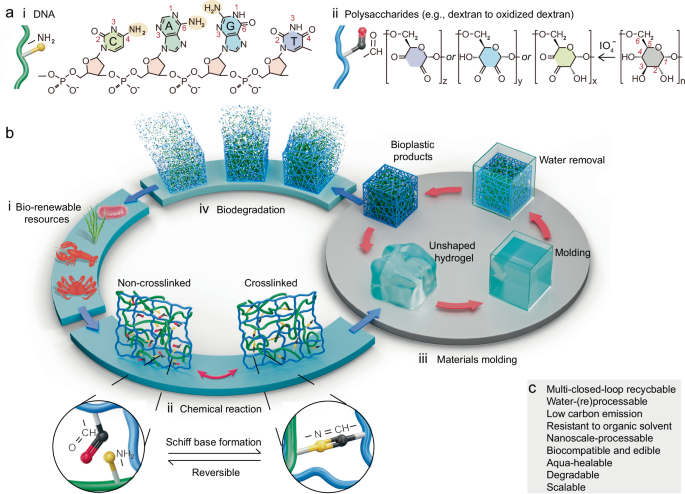
a Chemical compositions of biomass (i) DNA and (ii) polysaccharides using dextran and oxidized dextran as examples. b Illustration of the multiple closed loop cycles of the DNA-polysaccharides-based bioplastics including the first cycle from (i) bio-renewable resources, (ii) chemical reaction, (iii) materials molding, to (iv) biodegradation, the second cycle of (ii) imine bond-based reversible chemical reaction, and (iii) the third cycle of a water-recyclable molding. c Highlights of the bioplastic merits.
After the oxidation of Dex, highly reactive aldehyde groups are generated, which can conjugate with amines of DNA under mild conditions, resulting in the formation of a Dex-DNA composite. The successful bonding between Dex and DNA chains is supported by nuclear magnetic resonance spectroscopy (NMR) (Fig. S1–S10), Fourier transform infrared (FTIR) spectroscopy (Fig. S11), and rheology measurements (Fig. 2a). In the ¹H NMR spectrum of oxidized Dex (Fig. S1), the aldehyde group shows a characteristic signal at ~δ 9.7 ppm33. No characteristic signal is observed at this region from natural-derived DNA (Fig. S2). Upon the formation of Dex-DNA, an additional signal is obtained at δ 9.2–9.3 ppm (Fig. S3), suggesting the formation of imine groups (RN = CHR’), which is also observed in recycled sample (Fig. S4). As amine group is on N6, N4 and N2 positions of adenine (A), cytosine (C) and guanine (G), respectively, but not thymine (T) (Fig. 1a i), to determine which bases interact with the aldehyde groups of Dex, DNA oligomers of nine bases (A9, C9 and G9) were used, respectively, to react with Dex. Compared to the ¹H NMR spectra of A9, C9, G9 (Fig. S5, S6, S7) and Dex (Fig. S1), the formed Dex-A9, Dex-C9 and Dex-G9 exhibit additional signals at ~δ 9.25, 9.26, 9.27 ppm (Fig. S8, S9, S10), respectively, corresponding to the formation of imine groups.
Fig. 2: Preparation and recycling of Dex-DNA bioplastics.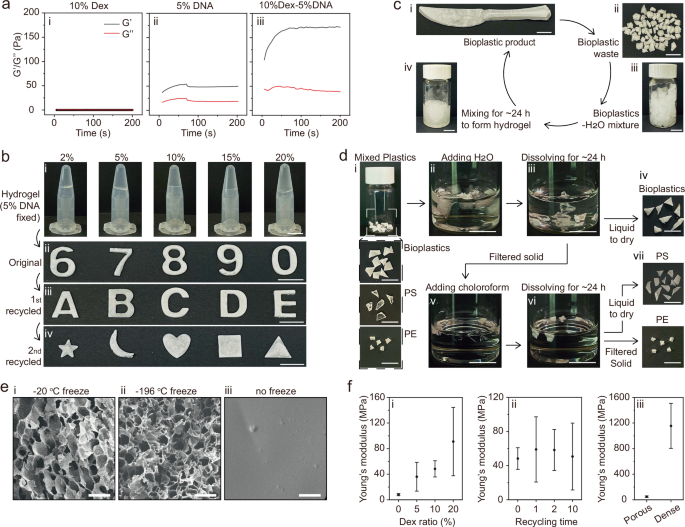
a Rheology characterizations of Dex (i), DNA (ii), and Dex-DNA (iii). b Photographs of the Dex-5%DNA hydrogels with different Dex contents (i), as well as their bioplastic products for original (ii), 1st (iii), and 2nd (iv) recycling. c Illustration of a typical water-processable recycling process. d Selective recycling processes for mixed plastics consisting of bioplastics, polyethylene (PE), and polystyrene (PS). e Representative SEM images of the bioplastics produced through –20 oC (i) and −196 oC (ii) freeze-drying, as well as without freeze-drying (room temperature, iii). Three independent experiments were conducted with similar results. f Analysis of Young’s modulus of the bioplastics with the impact of Dex contents (i), recycling cycles (ii), and microstructures (iii). Data are presented as mean±standard deviation (n = 3). The scale bar is 1 cm in (b-d) and 50 μm in (e).
IR measurements further validate the reversible imine bond formation. In the FTIR spectra (Fig. S11), the −C=O stretching vibration (1650 cm⁻¹, 1631 cm⁻¹) and −N-H stretching vibration (3332 cm⁻¹, 3210 cm⁻¹) are observed on the DNA. Compared to Dex, the oxidized Dex exhibits a low-intensity signal at 1732 cm−1, corresponding to the −C=O stretching from aldehyde groups33. Upon the formation of Dex-DNA composite, −C=N stretching vibration of Schiff base exhibits a characteristic peak at 1654 cm⁻¹, which is also observed in the recycled sample. The reversible nature of imine bonds offers significant potential for chemical recycling27,28,29, complemented by water-(re)processability under mild conditions, while it compromises the bioplastic stability in humid/acidic environments, as discussed in the following sections. Moreover, we note that reversible imine bonds support chemical recycling, while other factors including chain composition, polymer crystallinity, particle size and environmental factors, such as enzymes, exposure to sunlight and mechanical abrasion (e.g., through wave action), also play key roles in polymer degradation and recycling.
Bioplastic samples are named according to their compositions and the solid weight percentages in the hydrogel state, unless otherwise specified. For example, 10%Dex-5%DNA refers to bioplastics prepared from hydrogels containing 10 wt.% oxidized Dex and 5 wt.% DNA. Rheology study reveals that the 10% Dex behaves as a liquid with G’ ≈ G” ≈ 0.1 Pa (G’, storage modulus, G”, loss modulus), and the 5% DNA forms a hydrogel with G’ value of ~50 Pa and G” value of ~20 Pa (Fig. 2a i and ii). In contrast, the formed 10%Dex-5%DNA composite exhibits as a hydrogel with significantly enhanced mechanical properties, showing G’ and G” values of ~170 Pa and 40 Pa, respectively (Fig. 2a iii). The increased G’ and G” values indicate a higher degree of crosslinking, attributed to the formation of imine bonds, cooperatively stabilized by H-bonds, between Dex and DNA. The formulation is proven effective for Dex-5%DNA hydrogels across a broad range of Dex concentrations, from 2% to 20% (Fig. 2b i). DNA is shown to be uniformly distributed within the Dex-DNA hydrogel, as evidenced by green fluorescence imaging (Fig. S12). Well-shaped bioplastic products could be derived from hydrogel composites (Fig. 2b ii). Increasing the Dex content in the composite results in hydrogels with higher G’ and G” values (Fig. S13a). These hydrogels exhibit a reduction in G’ value with elevated temperature from 20 to 80 oC (Fig. S13b). Moreover, the generated Dex-DNA bioplastics can be successfully recycled and re-shaped into various configurations (Fig. 2b iii and iv). Notably, the solid content in the hydrogel plays a crucial role in the shrinkage of generated bioplastics. For example, a bioplastic sample with a 4% solid content (2% Dex and 2% DNA) showed significant shrinkage within 60 minutes after transferring from freeze dryer to atmospheric conditions (Fig. S14), which is ascribed to the lack of sufficient solid to support the porous structures under ambient atmosphere.
A typical closed-loop recycling process is illustrated in Fig. 2c, using a knife-like 10%Dex-5%DNA bioplastic as an example (Fig. 2c i). The bioplastic waste (Fig. 2c ii) is recycled by adding water (Fig. 2c iii), followed by a mixing process to fully dissolve the bioplastics to form a hydrogel (Fig. 2c iv). The recycled hydrogel was used to produce solid bioplastic products through the same freeze-drying and molding process. Both the original and recycled bioplastics are observed with the characteristic imine signals at δ 9.2–9.3 ppm and 1654 cm⁻¹ of the −C=N stretching vibration in the ¹H NMR (Fig. S4) and FTIR spectra (Fig. S11), respectively, suggesting the recyclability. Importantly, the water-processable recycling capability allows the bioplastics to be recovered from mixed plastic wastes, a common challenge in daily plastic recycling. We demonstrate this by mixing the bioplastics with two widely used commercial plastics: polystyrene (PS) and polyethylene (PE) debris (Fig. 2d i). The recycling is carried out through selective solvent dissolution. Water and chloroform are used to selectively recover the bioplastics and PS from the mixed plastics. The bioplastics swell in water (Fig. 2d ii) and fully dissolve after approximately 24 hours (Fig. 2d iii). The solid and liquid components are separated by filtration, and the recycled bioplastic solid is obtained by drying the liquid phase (Fig. 2d iv). The remaining solid is further separated by adding chloroform (Fig. 2d v). The PS plastic debris dissolves completely after ~24 hours (Fig. 2d vi). Recovered PS and PE solids are then obtained from the liquid and solid phases, respectively (Fig. 2d vii).
The freezing and drying process is critical for controlling the microstructures of the produced bioplastics. Scanning electron microscope (SEM) results indicate that the freezing-drying method generates porous microstructures, with bioplastics frozen at −20 oC exhibiting larger pores (Fig. 2e i) compared to these rapidly frozen using liquid nitrogen (−196 oC) (Fig. 2e ii). The bioplastic pore sizes are approximately 10-40 μm (Fig. 2e i) and 2-10 μm (Fig. 2e ii) prepared under –20 oC and –196 oC conditions, respectively. Moreover, bioplastics dried directly at room temperature display a dense surface with no observable pores at the microscale (Fig. 2e iii). During room-temperature drying, the gradual evaporation of water enables polymer chains within the hydrogel to reorganize and deposit along the mold boundaries, see schematic illustration in Fig. S15. This confined drying promotes the formation of a dense, shaped bioplastic structure, as the capillary forces and polymer interactions guide the hydrogel shrinkage and consolidation within the mold cavity. The dense bioplastics exhibit a stable water vapor transmission rate (WVTR) of ~480-500 g/m2·day and permeability (P) of ~200 g·mm/m2·day·kPa on both initial and recycled samples (Fig. S16). The melting point is measured to be 166 oC and 160 oC in the initial and recycled bioplastics, respectively (Fig. S17), without significant variation.
We performed the tensile tests to investigate changes in the bioplastic’s properties throughout the preparation and recycling processes. The results indicate that, with a fixed DNA content of 5%, increasing Dex content from 5% to 20% significantly enhances Young’s modulus from ~36 MPa to ~91 MPa (Fig. 2f i and Fig. S18). All Dex-DNA bioplastics exhibit a higher Young’s modulus than the pure DNA sample, which has a modulus of ~8 MPa. This demonstrates that Dex-DNA bioplastics possess significantly improved stiffness compared to DNA alone. Additionally, even after 10 times recycling, Young’s modulus shows no significant decline (Fig. 2f ii and Fig. S18), highlighting the high recyclability of these bioplastics. Moreover, bioplastics prepared by room-temperature drying (without freezing) exhibit notably higher Young’s modulus compared with porous bioplastics (Fig. 2f iii and Fig. S18). For example, using the same 10%Dex-5%DNA formulation, room-temperature dried bioplastics exhibit Young’s modulus of ~1155 MPa, approximately 24 times higher than that achieved through −20 oC freeze-drying, ~48 MPa, (Fig. 2f iii). This difference is primarily attributed to the microstructure variation between the dense and porous samples (Fig. 2e). Further comparison between previously reported studies (DNA-based24,25 and water-processable plastics5,34,35,36) and several typical commercial plastics (Fig. S19)37 and the presently introduced bioplastics was conducted. It is found that the Young’s modulus of the bioplastic is higher than that of DNA-based plastics/gels24,25, and closely overlaps the values demonstrated by biofilm-/protein-based bioplastics5,36, high-/low-density polyethylene (HDPE/LDPE)37, and polyvinylidene fluoride (PVDF)37. These results confirm the bioplastics’ high recyclability and demonstrate that their mechanical properties can be fine-tuned by adjusting the freezing process during the preparation process.
We further demonstrate that bioplastics possess several key advantages in terms of chemical resistance and aqua-healing properties. Notably, the bioplastics exhibit intrinsic resistance to several commonly used solvents: they show negligible damages after soaking for 7 days in hexane (Fig. 3a i), chloroform (Fig. 3a ii), and dimethyl sulfoxide (DMSO) (Fig. 3a iii). It is worth mentioning that chloroform can dissolve petroleum-derived PS and low-density polyethylene (LDPE)11. The bioplastics exhibit slow dissolution in ethylene glycol or softening/swelling in glycerol and formamide (Fig. S20 and Movie S1–2). While rapid dissolution of bioplastics under extremely acidic (pH ~1, Fig. S21a) and basic (pH ~14, Fig. S21b) conditions is obtained. Additionally, the bioplastics demonstrate excellent aqua-healing capability, illustrated by a knife-shaped bioplastic. After breaking, the fractured pieces are reassembled to their original shape by applying water to the broken interface, followed by a drying process (Fig. 3b i). A subsequent tensile test demonstrates that there is no significant change in Young’s modulus before and after the healing process, confirming the high reliability of the aqua-healing feature (Fig. 3b ii). It is worth mentioning that water processability, including water-based molding and aqua-healing, is a relatively eco-friendly approach. Nevertheless, this indicates the relatively poor moisture resistance of the produced bioplastics. Thus, for practical applications such as packaging materials where high moisture resistance is necessary, further processing of the Dex-DNA bioplastics is required. Potential methods include applying moisture-resistant layers, such as hydrophobic coating (e.g., polydimethylsiloxane), to these bioplastics.
Fig. 3: Properties of the bioplastics: chemical resistance, aqua-healing, precise processability, and biodegradation.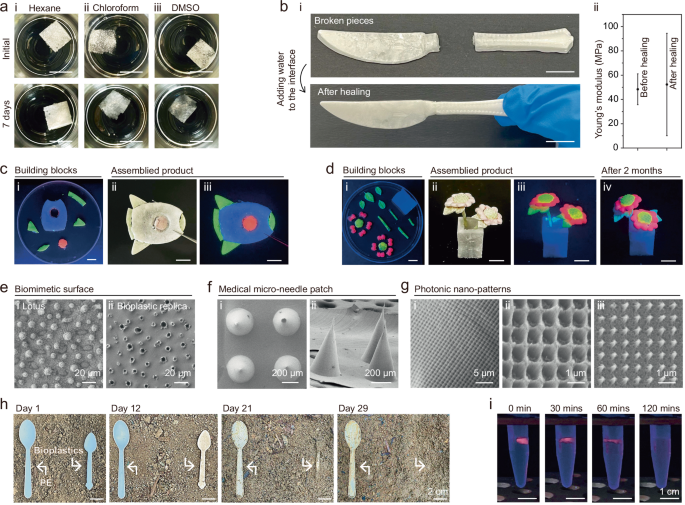
a Photographs of bioplastic samples soaked in various chemicals, including hexane (i), chloroform (ii), and dimethyl sulfoxide (DMSO) (iii), at day 0 and day 7. b Photographs of an aqua-healing process on a knife-shaped product (i), and Young’s modulus analysis before and after aqua-healing (ii). Data are presented as mean±standard deviation (n = 3). Photographs of the assembly of building blocks into a 2D rocket (c) and a 3D flower (d) under UV irradiation or exposure to natural light. The bioplastics were stained with fluorescent dyes. Representative SEM images of the (e) biomimetic surface, (f) microneedle patch, and (g) photonic nano-patterns. Three independent experiments were conducted with similar results. (h, i) Photographs of the biodegradation process of the bioplastics: (h) buried in soil under real-world conditions, and (i) degraded in the lab using DNase I with GelRed staining to visualize the degradation more clearly. The scale bar is 1 cm in (a–d).
The bioplastics are highly processable to form well-shaped products, ranging from centimeter to nanometer scale. The centimeter-scale samples were prepared using the –20 oC freeze-drying method. Beyond the single-piece molding, we also present an effective strategy that assembles building blocks to generate complex 2D and 3D products (Fig. 3c, d). The building blocks are bioplastic pieces stained with DNA intercalating fluorescent dyes, GelRed (red), DAPI (blue), and SYBR green I (green). Under UV irradiation, the bioplastic building blocks exhibit uniform coloration (Fig. 3c i, d i), indicating homogeneous DNA distribution. They are assembled using the aqua-healing method, resulting in well-formed centimeter scale products with slightly discolored appearances (Fig. 3c ii, d ii), but vibrant, high-contrast fluorescence under UV irradiation (Fig. 3c iii, d iii), validating the building block strategy. Additionally, the assembled bioplastics exhibit excellent durability. A 3D flower-shaped sample retains its shape and high-contrast fluorescent colors (Fig. 3d iv) after 2 months of storage in Singapore’s challenging environment (23-34 oC, 80-90% humidity), which is harsher than cold or arid climates.
Moreover, such bioplastics offer high-precision manufacturing down to the nanoscale. This capability is demonstrated through three representative applications, where plastics are commonly used, including biomimetic surfaces (Fig. 3e), medical microneedle patches (Fig. 3f), and photonic nano-patterns (Fig. 3g). A direct drying method with specific templates was applied to achieve precise nanoscale fabrication. The biomimetic surface accurately replicates the original surface texture of a Lotus leaf (Fig. 3e). The microneedle patches feature well-defined conical structures with ~300 µm in diameter and sharp tips (Fig. 3f), and can penetrate the stratum corneum of mouse (Fig. S22), which might be further developed as monitoring and delivery devices. The nano-patterns are commonly used for photonic devices, to which the bioplastics are also applicable. The bioplastics are produced into a series of patterns, including rectangular textures (Fig. 3g i), grids (Fig. 3g ii), and pyramid arrays (Fig. 3g iii). Remarkably, no defects are observed across tens of micrometers (Fig. 3g i), and the feature size reaches as fine as ~150 nm (Fig. 3g ii and iii). These results highlight the promise of bioplastics for precise, durable products across multiple scales.
To assess its biodegradability, we conducted an experiment in a practical case using a spoon-shaped bioplastic sample alongside a commercial PE-based disposable spoon as a reference. Both were buried in local soil. Over time, the bioplastic sample decayed gradually, achieving complete degradation after 29 days, while the reference PE spoon retained its original shape throughout the experiment (Fig. 3h). We also conducted a biodegradation test according to the standards of American Society for Testing and Materials (ASTM), and demonstrated that the degradation ratio is ~28% after 45 days (Fig. S23). Moreover, we demonstrated that the degradation process can be accelerated with nucleases. The bioplastic sample, stained with GelRed for better illustration, was monitored under UV irradiation to visualize the degradation process. In water containing DNase I nuclease, the red bioplastic gradually decreased in size and fully disappeared in 120 minutes (Fig. 3i), significantly faster than in soil. Increasing the nuclease concentration further reduced degradation time to 10-20 minutes (Fig. S24a). The rapid biodegradation in the lab is attributed to the DNA content in the bioplastic, which makes it susceptible to enzymatic breakdown. In contrast, without nuclease, the red-stained bioplastic remained intact in water after 120 minutes (Fig. S24b). Incorporating DNA into the bioplastic matrix offers a key advantage by introducing an additional, orthogonal degradation pathway beyond those available to polysaccharide-based systems alone. While enzymatic degradation of polysaccharides—such as dextran hydrolysis by dextranase—is well-established, these pathways are typically limited to specific glycosidic linkages. DNA, in contrast, is easily degraded by a distinct set of enzymes (e.g., DNase), which are abundant in many natural environments. This approach not only broadens the environmental triggers for material breakdown but also enables more tunable and potentially faster degradation profiles. Moreover, the inclusion of DNA adds chemical diversity to the bioplastic, offering additional handles for molecular design and programmability that are not easily accessible with polysaccharides alone. These results highlight minimal environmental risks posed by uncollectable bioplastic waste, e.g., the threat of microplastics to the ecosystem, and suggest that enzymatic degradation could serve as an efficient end-of-life treatment for large-scale bioplastic disposal in industrial applications.
To demonstrate the universality of this method to produce polysaccharide-DNA bioplastics, we replicated the freeze-drying process by replacing Dex with either AA (Fig. 4a–c) or CMC (Fig. 4d–f). Both AA and CMC were oxidized using NaIO4, with their respective oxidization mechanisms illustrated in Fig. 4a, d, respectively. Both the AA-DNA and CMC-DNA bioplastics are recyclable and reusable through the same water-processable method. The typical recycling process was demonstrated using samples with 5% DNA and 10% polysaccharides (AA or CMC), as illustrated in Fig. 4b, e. It is demonstrated that bioplastics could be produced using hydrogels with a broad range of AA or CMC concentrations (2- 20 wt.%, Fig. 4c, f). As the AA or CMC concentrations increased from 2 to 20 wt.%, both AA-DNA and CMC-DNA hydrogels exhibited an increasing G’ value (Fig. S25). The resulting bioplastics were found to be recyclable through water-based processing (Fig. S26a-b and S27a-b), and both types also demonstrated aqua-healing capabilities (Fig. S26c and S27c). Additionally, mechanical tests revealed that Young’s modulus averaged ~116 MPa for 10%AA-5%DNA sample and ~92 MPa for 10%CMC-5%DNA sample (Fig. S28), highlighting their robustness and versatility.
Fig. 4: Universality of the method and bioplastic biocompatibility.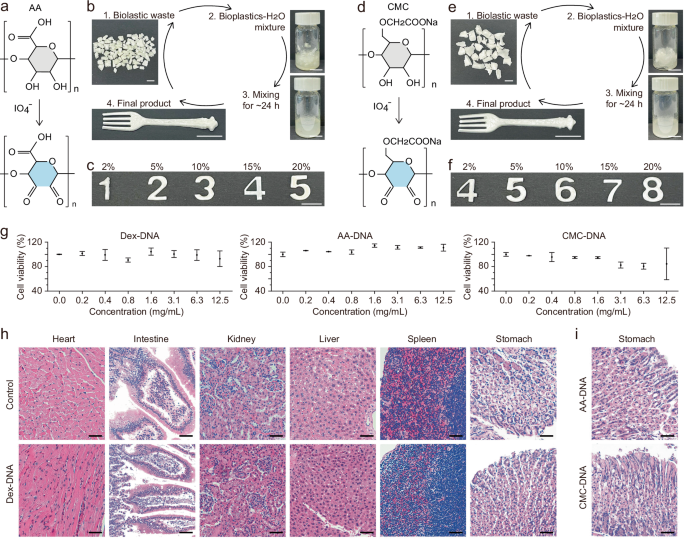
Molecular structure changes of (a) AA and (d) CMC under an oxidization process. Illustration of recyclable processes of the (b) AA-DNA and (e) CMC-DNA bioplastics. Photographs of the (c) AA-5%DNA and (f) CMC-5%DNA bioplastics with different polysaccharide contents of 2%−20%. g Cytotoxicity assessment of the three bioplastic formulations, showing cell viability across concentrations. Data are presented as mean±standard deviation (n = 3). h Representative microscopy images of stained mice organ sections 14 days after ingesting Dex-DNA bioplastics, with comparisons to control group images. Examined organs include heart, intestine, kidney, liver, spleen, and stomach. i Representative microscopy images of stained mice stomach sections 14 days after exposure to AA-DNA and CMC-DNA bioplastics. The scale bar is 1 cm in (a–f) and 50 μm in (h, i).
To assess the biocompatibility of the bioplastics, we conducted in vitro cytotoxicity tests using primary human dermal fibroblasts and in vivo digestion experiments on mice. The in vitro assessments suggest that cell viability remains above 80% across all three bioplastics: Dex-DNA, AA-DNA, and CMC-DNA (Fig. 4g) within a concentration range of 0 to 12.5 mg/mL, with no significant declining trends observed. For the in vivo evaluation, histological examination demonstrated no noticeable differences in body weight between mice fed with the three bioplastics (Dex-DNA, AA-DNA, and CMC-DNA) and the control group after 14 days (Fig. S29a). Moreover, no observable pathological damage was found in major organs, including heart, intestine, kidney, liver, spleen, and stomach, when compared with the control group (Figs. 4h, i, and S29b). Notably, unlike microplastic residues that pose health risks to organisms12,13,14, no such residues were detected in the organ sections. These results indicate the biocompatibility and biosafety of the polysaccharide-DNA bioplastics, which can be attributed to the inherently safe nature of their raw components−polysaccharide and biomass-derived DNA.
We further demonstrate the scalability of the production process and assess the potential environmental impacts of upscaling the production of these bioplastics, using the 10%Dex-5%DNA formulation as a case study. Large-scale hydrogel batches of 500 mL were successfully produced (Fig. 5a), and the bioplastic foils covering ~12.5 ×12.5 cm2 were fabricated (Fig. 5b), alongside various morphologies designed to meet potential commercial demands (Fig. 5c). Interestingly, the bioplastic foils with a high solid content exhibit a transparent appearance (Fig. 5b), contrasting with the white, opaque appearance of products generated through freeze-drying (Fig. 5c). This difference arises from the microstructural features, where the porous structure of freeze-dried samples scatters visible light more strongly, resulting in the white appearance. These results indicate that the optical properties of the bioplastics can be customized to suit various practical applications, offering flexibility for product design and functionality.
Fig. 5: Production upscaling and environmental impact analysis.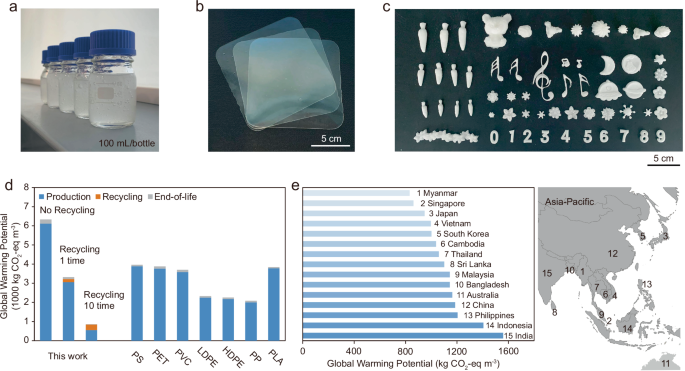
a Photographs of the upscaling production of 10%Dex-5%DNA hydrogels. Images of bioplastic products in foil form (b) and with various morphologies (c), created using 10%Dex-5%DNA hydrogels. (d) Comparison of the Global Warming Potential (GWP) per use cycle across different recycling times for the bioplastics versus commercial plastics, including polystyrene (PS), polyethylene terephthalate (PET), polyvinyl chloride (PVC), low-density polyethylene (LDPE), high-density polyethylene (HDPE), polypropylene (PP), and polylactic acid (PLA). e GWP of bioplastics recycled 10 times across different countries/regions. Map adapted from a public domain image on Wikimedia Commons (https://commons.wikimedia.org/wiki/File:Location_Map_Asia.svg). No copyright restrictions apply.
To assess the environmental impacts of the produced bioplastics, we conducted a cradle-to-grave ex-ante LCA38,39,40, and compared them with widely used commercial plastics, including PS, polyethylene terephthalate (PET), polyvinyl chloride (PVC), LDPE, high-density polyethylene (HDPE), polypropylene (PP), and polylactic acid (PLA) (Fig. 5 d, e). The functional unit for the assessment is 1 m3 of plastic for single-use applications. The end-of-life scenario assumes industrial composting for both the bioplastic and PLA, while landfilling is considered for other commercial plastics. The detailed recycling process of the bioplastics is documented in the Methods section. When the bioplastic is recycled 10 times, its life-cycle Global Warming Potential (GWP) is 861 kg CO2-eq m-3, 58.7% to 78.3% lower than that of commercial plastics without recycling (Fig. 5d). In contrast, without recycling, the GWP of the bioplastic rises to 6,332 kg CO2-eq m-3, 59.4% to 203.3% higher than the commercial plastics. This is due to emissions from the production phase are distributed across multiple reuse cycles when recycling cycles increase (Fig. 5d). Given the significant impact of electricity on the GWP, we analyze how different regional electricity sources influence the results in various geospatial locations near Singapore (Fig. 5e). Along with Singapore, Myanmar, Japan, Vietnam, and South Korea exhibit relatively low GWP values (832–1002 kg CO2-eq m-3). In contrast, regions with more carbon-intensive energy grids, such as India, Indonesia, Philippines, and China, display higher GWP values (1,186-1,560 kg CO2-eq m-3). These results suggest the importance of adopting low-carbon electricity for bioplastic production and recycling. The comparison results to commercial plastics that are recycled 10 times are also available in Fig. S30. The results of other environmental impact categories are available in Fig. S31 with the details of the contribution analysis in Table S1. Given that the current production process is still at the lab scale, further reductions in life-cycle greenhouse gas emissions are expected through process optimization and sustainable raw material sourcing in large-scale manufacturing. While offering environmental benefits, the current lab-scale production of these bioplastics incurs a raw materials cost of 3.1-5.2 USD/gram (Table S2), which is relatively high. Future cost reduction, including more affordable extraction techniques, optimization of raw material supply chains, and the use of more energy-efficient fabrication equipment, are anticipated to be critical factors for successful commercialization.
In summary, the present study introduces a sustainable bioplastic material, revealing multi-closed-loop recyclability and water (re)processability. The bioplastics are based on abundant polysaccharide biomass products, such as Dex, AA, CMC, and DNA of plants or living organism waste. Chemical (NaIO4), partial oxidation of the polysaccharides to aldehyde−functionalized polysaccharides followed by reversible imine covalent bond formation with amine functionalities associated with DNA yield water processable polysaccharide/DNA crosslinked hydrogels as a raw material to produce sustainable bioplastic products. The plastic products exhibit (bio)degradability and recyclability reflected by the aqueous recycling of the parent gel constituents by hydrolysis of the plastics and biodegradability of the DNA/polysaccharides by native biocatalysts (enzymes), e.g., bacteria. The resulting bioplastics reveal resistance towards organic solvents, aqua-healing capacities, scalability, and effective processing across nanometer, micrometer, centimeter to meter scales, suggesting broad and versatile applications. The LCA reveals that the production of 1m3 of the bioplastic results in 861 kg CO2-eq m-3 emission when recycled 10 times, which is 58.7%-78.3% lower than most commercial plastics without recycling. Moreover, we note that the DNA extracted from different sources might differ in sequence, length, and secondary structure. These might affect the resulting bioplastic due to differences in the imine bond densities, and consequently, influence their mechanical properties (e.g., Young’s modulus). Moreover, the key characteristics of the bioplastics, including enzymatic degradability and close-loop recyclability, should be retained. Nevertheless, harnessing pure sequence-programmed DNA stocks could be produced by genetically-engineered crops. While such approaches are at present cost-prohibitive and impractical for large-scale sustainable material production, for special material applications, adaptation of these concepts might be interesting. Furthermore, the concept of polysaccharide/DNA bioplastics based on reversible imine-crosslinked frameworks may be extended to polysaccharide/protein crosslinked matrices. At present, the need for a cost-effective “clean” source for NaIO4 is a limiting factor in the process. The use of solar light to produce IO4- or, alternatively, the solar-light photocatalyzed oxidation of the polysaccharides to the aldehyde-modified polysaccharides could potentially overcome this limitation. Photocatalyzed oxidation of iodide to periodate in aqueous basic solutions, or photocatalyzed oxygen-mediated Fenton oxidation of I-, could provide parallel close-hoops for the present process, synthesizing the bioplastic materials. The present study provides, however, important potential pathways, advancing sustainable, environment-friendly bioplastic materials.
